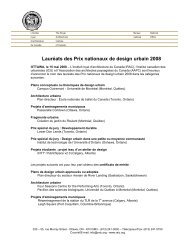BIM - Practice Builder - Royal Architectural Institute of Canada
BIM - Practice Builder - Royal Architectural Institute of Canada
BIM - Practice Builder - Royal Architectural Institute of Canada
Create successful ePaper yourself
Turn your PDF publications into a flip-book with our unique Google optimized e-Paper software.
RAIC PRACTICE BUILDER<br />
A summary <strong>of</strong> the advantages <strong>of</strong> switching from 2D CAD to <strong>BIM</strong> include:<br />
• <strong>BIM</strong> works the way designers think by using the common language <strong>of</strong> building<br />
elements (wall, door, floor etc.);<br />
• Document coordination is enhanced and simplified. A single building information<br />
model allows consistent and coordinated views and details to be selected easily for<br />
sheet layout and printing;<br />
• Clients now expect 3D visualizations. <strong>BIM</strong> s<strong>of</strong>tware allows an output, ranging from<br />
simple grey scale 3D representations, cut-away 3D sections to photorealistic<br />
renderings from a single building information model without the need for<br />
specialized s<strong>of</strong>tware or skills;<br />
• Collaboration with other architects, designers and consultants is simplified with the<br />
interoperable platform <strong>of</strong> <strong>BIM</strong> s<strong>of</strong>tware;<br />
• <strong>BIM</strong> models can be exported to common drawing formats (such as .dwg or .dxf),<br />
and to spreadsheets to create schedules (invaluable for costing, material take-<strong>of</strong>fs,<br />
etc.)<br />
What is an Integrated Design Process and what does it have<br />
to do with <strong>BIM</strong>?<br />
The Integrated Design Process (IDP) is based on the “whole building systems approach”. It<br />
brings together key stakeholders and design pr<strong>of</strong>essionals, such as building owners, facility<br />
managers, developers, designers, engineers, consultants, and occupants, as a core team to<br />
work collaboratively and interactively from the early planning stages through to building<br />
occupation. 2<br />
Many architectural practitioners have recognized the value <strong>of</strong> IDP and are already employing<br />
integrated design and integrated project delivery systems. The adoption <strong>of</strong> <strong>BIM</strong> within the<br />
IDP complements and facilitates the design teams’ identification and understanding <strong>of</strong> the<br />
various design goals, and it provides a mechanism to realize those multiple design goals. A<br />
design team, whose participants are all working within single or linked <strong>BIM</strong>s, are better able<br />
to visualize problems, analyze potential points <strong>of</strong> conflict, provide creative solutions, and ultimately<br />
minimize design “errors”.<br />
Why does Interoperability matter?<br />
Overview<br />
As architects and most architectural practices embraced computer-assisted design (CAD)<br />
in the 1980’s it became very clear that there was no common computer language linking one<br />
2 www.gvrd.bc.ca<br />
4

















